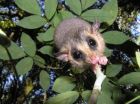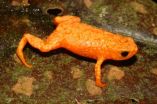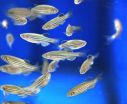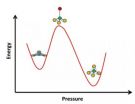(Press-News.org) Brazil could conserve its valuable Atlantic Forest by investing just 0.01 per cent of its annual GDP, according to a new study.
The Atlantic Forest (Mata Atlântica) is one of the most important and threatened biodiversity hotspots in the world, containing the only living examples of nearly 10,000 species of plant and more bird species than all of Europe.
Situated along the Atlantic coast of Brazil, it once covered an area of nearly 1.5 million square kilometres. Today, the forest is home to more than 130 million people and it covers only 160,000 km2, because of deforestation.
Reporting in the journal Science, a team of international scientists have calculated that it would cost US$198 million per year to pay private owners to set aside land for reforestation.
Together with the conservation of existing tracts, this would be enough to conserve the majority of species and many of the benefits that come from the forest's ecosystem, such as pest control and pollination.
US$198m is equivalent to only 6.5 per cent of what Brazil already invests in agricultural subsidies and less than 0.01 per cent of the country's annual GDP.
There are already some schemes in Brazil to pay private land owners to set aside land to conserve the forest, preserve species and maintain healthy ecosystems, but these have been local-scale initiatives that have had little impact on maintaining and improving the conditions of the forest as a whole.
Lead researcher Dr Cristina Banks-Leite, from the Department of Life Sciences at Imperial College London, said: "The Atlantic Forest is smaller and far more degraded than the Amazon rainforest, but it is also contains a vast range of biological diversity. The forest is a crucial habitat that is home to more than half of Brazil's threatened animal species. At the moment, outside of protected areas, nearly 90 per cent of the Atlantic Forest has less than 30 per cent of forest cover remaining. This is quite simply not enough to ensure the survival of species and maintenance of a thriving ecosystem across rural areas".
"Our study shows that it would be relatively cheap to secure the future of the forest - and protect its plants, birds and other animals – by paying land owners on a large scale to set aside land for conservation. Local communities and land-owners will benefit not only from regular payments but also from the benefits that a flourishing ecosystem brings. We need to start to put such a scheme in place now, before it becomes too late."
In this new study scientists calculated how much it would cost to set aside land in priority landscapes across the whole Atlantic Forest in order to restore the minimum amount of habitat needed to conserve biodiversity and maintain ecosystem functions. Their findings reveal:
At least 30 per cent of native habitat needs to be preserved to maintain current levels of biodiversity
It would cost US$198 million per year, for the first three years, to set aside and reforest enough land to a minimum of 30 per cent forest cover.
This is the equivalent of 0.0092 per cent of Brazil's annual GDP, a figure that would reduce to 0.0026 per cent once active restoration costs are no longer needed.
To calculate costs the researchers first had to record what and how many species are currently living in pristine and degraded areas of the Atlantic Forest.
Over a period of nine years, a team of more than 100 researchers led by Dr. Renata Pardini, Dr. Marianna Dixo and Prof. Jean Paul Metzger from the University of São Paulo, collected data on birds, mammals and amphibians living in the forest. Using mist nets to capture birds as well as pitfall traps to capture mammals and amphibians, they painstakingly recorded information on 25,000 individuals, made up of 140 species of birds, 43 species of mammals and 29 species of amphibians.
They collected data in 79 different forest regions across 150 kilometres and estimated that to maintain a similar level of biodiversity and ecosystem functions which are found in protected areas, such as national parks, a minimum of 30 per cent of native habitat needs to be preserved.
To evaluate overall costs of maintaining minimum forest cover the scientists combined current estimates of existing forest cover with average costs paid to private land owners, and found that preserving the forest is feasible and low-cost.
Prof. Jean Paul Metzger from the University of Sao Paulo, another lead author of the study, said: "Our study shows a clear threshold of biodiversity losses with deforestation; below this threshold, not only many species disappear, but the functions they perform in the ecosystem will also decline, many of which are highly beneficial to humans. This threshold is important to identify win-win situations where both agriculture production and biodiversity conservation is optimized. Furthermore, this information can be a practical tool for planning sustainable landscapes, and should be incorporated into different land use policies, such as the Brazilian Forest Code, programs for ecosystems payments or in socio-environmental certification incentives."
The researchers are now hoping to work with local non-governmental organisations (NGOs) and the Brazilian government to implement a set-aside scheme that would be most cost-effective and beneficial to local people.
INFORMATION:
The study was carried out as part of Imperial College London's Grand Challenges in Ecosystems and Environment Initiative, and was conducted in collaboration with the Universidade de São Paulo, University of Minnesota, Universidade Estadual Paulista and University of Toronto.
*** High-resolution photographs of 13 species of amphibian, mammal and bird from the Atlantic Forest are available to accompany this release – see notes to editors to download ***
Contact:
Gail Wilson
Research Media Officer - Faculty of Natural Sciences
Tel: +44 (0)20 7594 6702
Duty press officer mobile: +44 (0)7803 886248
Email: gail.wilson@imperial.ac.uk
Notes to editors:
1. Original photos of amphibians, mammals and birds from the Atlantic Forest (under STRICT EMBARGO for 28 August at 14.00 US Eastern Time) can be downloaded using this dropbox link. Caption and credit info is below. The photographs were taken by members of the study team.
https://www.dropbox.com/sh/eatzhbmh29o004h/AAD0qn4ANESg_olsxx9-T3qOa
Brachycephalus crispus: Brachycephalus crispus is a recently-described species that is endemic to the Serra do Mar mountain range in the Atlantic Forest. Individuals are smaller than 2 mm. Credit: Thais H. Condez.
Brachycephalus guarani: Brachycephalus guarani is a recently-described species that is endemic to the Serra do Mar mountain range in the Atlantic Forest. Individuals are smaller than 2 mm. Credit: Thais H. Condez.
Delomys sublineatus: The Pallid Atlantic Forest Rat (Delomys sublineatus) is a terrestrial species endemic to the Atlantic Forest. Credit: Thomas Püttker
Drymoreomys albimaculatus 1 and 2: the Montane forest rat (Drymoreomys albimaculatus) is a recently described species, that only occurs in the Atlantic Forest. Credit: Thomas Püttker
Gracilinanus microtarsus 1, 2 and 3: The Brazilian Gracile opossum (Gracilinanus microtarsus) is a marsupial endemic to the Atlantic Forest. Credit: Thomas Püttker
Juliomys sp: This species of Juliomys is endemic to the Atlantic Forest and its diet consists of fruits and seeds. Credit: Thomas Püttker
Marmosops incanus: The Gray slender opossum (Marmosops incanus) is a generalist species occurring in several biomes in South America. Credit: Thomas Püttker
Micoureus paraguayanus: The Tate's woolly mouse opossum (Micoureus paraguayanus) is mostly endemic to the Atlantic Forest and was found to benefit from habitat loss. Credit: Thomas Püttker
Monodelphis iheringi: The Ihering's Three-striped Opossum (Monodelphis iheringi) is endemic to the Atlantic Forest and weighs in average 11 g. Credit: Thomas Püttker
Oligoryzomys nigripes: The Black-footed Colilargo (Oligoryzomys nigripes) is a generalist species that occurs in several biomes in South America. Credit: Thomas Püttker
Oxymycterus sp: This species of Oxymycterus weights around 80g and has an omnivorous diet. Credit: Thomas Püttker
Phyllomys nigrispinus 1 and 2: The Black-spined Atlantic Tree-rat (Phyllomys nigrispinus) is endemic to the Atlantic Forest and its diet consists mostly of leaves. Credit: Thomas Püttker
Tangara seledon 1-4: The Green-headed Tanager (Tangara seledon) is one of the most colorful birds in forests of Southeastern Brazil. Credit: Sandro Von Matter
2. Banks-Leite, C. et al. "Using ecological thresholds to evaluate the costs and benefits of set asides in biodiversity hotspots" Science, August 2014.
3. About Imperial College London
Consistently rated amongst the world's best universities, Imperial College London is a science-based institution with a reputation for excellence in teaching and research that attracts 14,000 students and 6,000 staff of the highest international quality. Innovative research at the College explores the interface between science, medicine, engineering and business, delivering practical solutions that improve quality of life and the environment - underpinned by a dynamic enterprise culture.
Since its foundation in 1907, Imperial's contributions to society have included the discovery of penicillin, the development of holography and the foundations of fibre optics. This commitment to the application of research for the benefit of all continues today, with current focuses including interdisciplinary collaborations to improve global health, tackle climate change, develop sustainable sources of energy and address security challenges.
In 2007, Imperial College London and Imperial College Healthcare NHS Trust formed the UK's first Academic Health Science Centre. This unique partnership aims to improve the quality of life of patients and populations by taking new discoveries and translating them into new therapies as quickly as possible.
Website: http://www.imperial.ac.uk
Less than $200 million would conserve precious Atlantic Forest in Brazil, say researchers
2014-08-28
ELSE PRESS RELEASES FROM THIS DATE:
Home is where the microbes are
2014-08-28
A person's home is their castle, and they populate it with their own subjects: millions and millions of bacteria.
A study published today in Science provides a detailed analysis of the microbes that live in houses and apartments. The study was conducted by researchers from the U.S. Department of Energy's Argonne National Laboratory and the University of Chicago.
The results shed light on the complicated interaction between humans and the microbes that live on and around us. Mounting evidence suggests that these microscopic, teeming communities play a role in human ...
New DNA study unravels the settlement history of the New World Arctic
2014-08-28
We know people have lived in the New World Arctic for about 5,000 years. Archaeological evidence clearly shows that a variety of cultures survived the harsh climate in Alaska, Canada and Greenland for thousands of years. Despite this, there are several unanswered questions about these people: Where did they come from? Did they come in several waves? When did they arrive? Who are their descendants? And who can call themselves the indigenous peoples of the Arctic? We can now answer some of these questions, thanks to a comprehensive DNA study of current and former inhabitants ...
Penn-NIH team discover new type of cell movement
2014-08-28
VIDEO:
Penn and NIH researchers have demonstrated a never-before characterized type of cell movement. In this video, a cell's vimentin cytoskeleton (green) pulls the nucleus (red) forward to generate a high-pressure...
Click here for more information.
For decades, researchers have used petri dishes to study cell movement. These classic tissue culture tools, however, only permit two-dimensional movement, very different from the three-dimensional movements that cells make in a ...
How the zebrafish gets its stripes
2014-08-28
This news release is available in German. The zebrafish, a small fresh water fish, owes its name to a striking pattern of blue stripes alternating with golden stripes. Three major pigment cell types, black cells, reflective silvery cells, and yellow cells emerge during growth in the skin of the tiny juvenile fish and arrange as a multilayered mosaic to compose the characteristic colour pattern.
While it was known that all three cell types have to interact to form proper stripes, the embryonic origin of the pigment cells that develop the stripes of the adult fish has ...
Watching the structure of glass under pressure
2014-08-28
Glass has many applications that call for different properties, such as resistance to thermal shock or to chemically harsh environments. Glassmakers commonly use additives such as boron oxide to tweak these properties by changing the atomic structure of glass. Now researchers at the University of California, Davis, have for the first time captured atoms in borosilicate glass flipping from one structure to another as it is placed under high pressure.
The findings may have implications for understanding how glasses and similar "amorphous" materials respond at the atomic ...
Bradley Hospital collaborative study identifies genetic change in autism-related gene
2014-08-28
PROVIDENCE, R.I. – A new study from Bradley Hospital has identified a genetic change in a recently identified autism-associated gene, which may provide further insight into the causes of autism. The study, now published online in the Journal of Medical Genetics, presents findings that likely represent a definitive clinical marker for some patients' developmental disabilities.
Using whole-exome sequencing – a method that examines the parts of genes that regulate protein, called exons - the team identified a genetic change in a newly recognized autism-associated gene, Activity-Dependent ...
Yale study identifies possible bacterial drivers of IBD
2014-08-28
Yale University researchers have identified a handful of bacterial culprits that may drive inflammatory bowel diseases (IBD) such as Crohn's disease and ulcerative colitis, using patients' own intestinal immune responses as a guide.
The findings are published Aug. 28 in the journal Cell.
Trillions of bacteria exist within the human intestinal microbiota, which plays a critical role in the development and progression of IBD. Yet it's thought that only a small number of bacterial species affect a person's susceptibility to IBD and its potential severity.
"A handful ...
Drug shows promise against Sudan strain of Ebola in mice
2014-08-28
August 28, 2014 — (BRONX, NY) — Researchers from Albert Einstein College of Medicine of Yeshiva University and other institutions have developed a potential antibody therapy for Sudan ebolavirus (SUDV), one of the two most lethal strains of Ebola. A different strain, the Zaire ebolavirus (EBOV), is now devastating West Africa. First identified in 1976, SUDV has caused numerous Ebola outbreaks (most recently in 2012) that have killed more than 400 people in total. The findings were reported in ACS Chemical Biology.
Between 30 and 90 percent of people infected with Ebola ...
NASA sees a weaker Tropical Storm Marie
2014-08-28
When NOAA's GOES-West satellite captured an image of what is now Tropical Storm Marie, weakened from hurricane status on August 28, the strongest thunderstorms were located in the southern quadrant of the storm.
NOAA's GOES-West satellite captured an image of Marie on August 28 at 11 a.m. EDT. Bands of thunderstorms circled the storm especially to the north. The National Hurricane Center noted that Marie has continued to produce a small area of convection (rising air that forms the thunderstorms that make up Marie) south and east of the center during some hours on the ...
DeVincenzo study breakthrough in RSV research
2014-08-28
MEMPHIS, Tenn. – The New England Journal of Medicine published research results on Aug. 21 from a clinical trial of a drug shown to safely reduce the viral load and clinical illness of healthy adult volunteers intranasally infected with respiratory syncytial virus (RSV).
Le Bonheur Children's Hospital and the University of Tennessee Health Science Center researcher Infectious Disease Specialist John DeVincenzo, MD, is lead author of this study.
RSV is the most common cause of lower respiratory tract infections in young children in the United States and worldwide. ...







